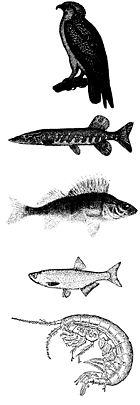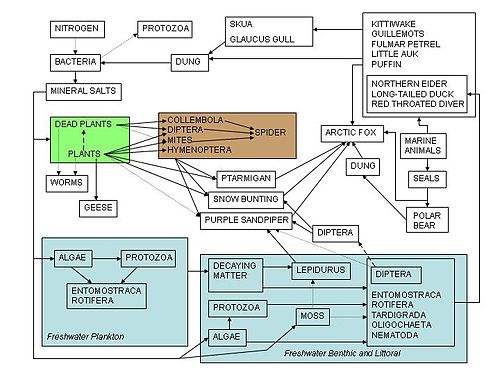Food chain
From Wikipedia, the free encyclopedia
Food chains, also called, food networks and/or trophic social networks, describe the eating relationships between species within an ecosystem. Organisms are connected to the organisms they consume by lines representing the direction of organism or energy transfer. It also shows how the energy from the producer is given to the consumer. Typically a food chain or food web. refers to a graph where only connections are recorded, and a food network or ecosystem network refers to a network where the connections are given weights representing the quantity of nutrients or energy being transferred.
Contents[hide] |
[edit] Organisms represented in food chains
Energy enters the food chain from the sun. Some energy and/or biomass is lost at each stage of the food chain as; feces (solid waste), movement energy and heat energy (especially by warm-blooded creatures). Therefore, only a small amount of energy and biomass is incorporated into the consumer's body and transferred to the next feeding level, thus showing a Pyramid of Biomass.
Primary producers, commonly forming autotrophs, produce complex organic substances (essentially "food") from an energy source and materials. These organisms are typically photosynthetic plants, which use sunlight as their energy source. A few, such as those organisms forming the base of deep-sea vent food webs, are chemotrophic, using chemical energy instead. Organisms that get their energy by organic substances are called heterotrophs. Heterotrophs include herbivores, which obtain their energy by consuming live plants; carnivores, which obtain energy from eating live animals. Ultimately detritivores, scavengers and decomposers may predate living or consume dead biomass.
[edit] Flow of food chains
A food chain is the flow of energy from one organism to the next and to the next and so on. Organisms in a food chain are grouped into trophic levels, based on how many links they are removed from the primary producers. Trophic levels may contain either a single species or a group of species that are presumed to share both predators and prey. They usually start with a plant and end with a carnivore. The diagram below is a food chain from a Swedish lake. Osprey feed on northern pike that feed on perch that eat bleak that feed on freshwater shrimp. Though unshown, the primary producers of this food chain are probably autotrophic phytoplankton. Phytoplankton and algae form the base of most freshwater food chains. It is often the case that biomass of each trophic level decreases from the base of the chain to the top. This is because energy is lost to the environment with each transfer. On average, only 10% of the organism's energy is passed on to its predator. The other 90% is used for the organism's life processes or it is lost as heat to the environment. Graphic representations of the biomass or productivity at each tropic level are called trophic pyramids. In this food chain for example, the biomass of osprey is smaller than the biomass of pike, which is smaller than the biomass of perch. Some producers, especially phytoplankton, are so productive and have such a high turnover rate that they can actually support a larger biomass of grazers. This is called an inverted pyramid, and can occur when consumers live longer and grow more slowly than the organisms they consume. In this food chain, the productivity of phytoplankton is much greater than that of the zooplankton consuming them. The biomass of the phytoplankton, however, may actually be less than that of the copepods. Directly linked to this are pyramids of numbers, which show that as the chain is traveled along, the number of consumers at each level drops very significantly, so that a single top consumer (e.g. a Polar Bear) will be supported by literally millions of separate producers (e.g. Phytoplankton).
[edit] Food web
A food web extends the food chain concept from a simple linear pathway to a complex network of interactions.
Food chains are overly simplistic as representatives of what typically happens in nature. The food chain shows only one pathway of energy and material transfer. Most consumers feed on multiple species and are, in turn, fed upon by multiple other species. The relations of detritivores and parasites are seldom adequately characterized in such chains as well. The food chain has a producer, consumer, herbivore, carnivore, omnivore, decomposer.
A food web is a set of interconnected food chains by which energy and materials circulate within an ecosystem (see Ecology). The food web is divided into two broad categories: the grazing web, which typically begins with green plants, algae, or photosynthesizing plankton, and the detrital web, which begins with organic debris. These webs are made up of individual food chains. In a grazing web, materials typically pass from plants to plant eaters (herbivores) to flesh eaters (carnivores). In a detrital web, materials pass from plant and animal matter to bacteria and fungi (decomposers), then to detrital feeders (detritivores), and then to their predators (carnivores).
Generally, many interconnections exist within food webs. For example, the fungi that decompose matter in a detrital web may sprout mushrooms that are consumed by squirrels, mice, and deer in a grazing web. Robins are omnivores, that is, consumers of both plants and animals, and thus are in both detrital and grazing webs. Robins typically feed on earthworms, which are detritivores that feed upon decaying leaves.
Herbivores, consumers of green plants, belong to the second trophic level. Carnivores, predators feeding upon the herbivores, belong to the third. Omnivores, consumers of both plants and animals, belong to the second and third. Secondary carnivores, which are predators that feed on predators, belong to the fourth trophic level. As the trophic levels rise, the predators become fewer, larger, fiercer, and more agile. At the second and higher levels, decomposers of the available materials function as herbivores or carnivores depending on whether their food is plant or animal material.
III Energy Flow Through these series of steps of eating and being eaten, energy flows from one trophic level to another. Green plants or other photosynthesizing organisms use light energy from the sun to manufacture carbohydrates for their own needs. Most of this chemical energy is processed in metabolism and dissipated as heat in respiration. Plants convert the remaining energy to biomass, both above ground as woody and herbaceous tissue and below ground as roots. Ultimately, this material, which is stored energy, is transferred to the second trophic level, which comprises grazing herbivores, decomposers, and detrital feeders. Most of the energy assimilated at the second trophic level is again lost as heat in respiration; a fraction becomes new biomass. Organisms in each trophic level pass on as biomass much less energy than they receive. Thus, the more steps between producer and final consumer, the less energy remains available. Seldom are there more than four links, or five levels, in a food web. Eventually, all energy flowing through the trophic levels is dissipated as heat. The process whereby energy loses its capacity to do work is called entropy.
The earliest food webs were published by Victor Summerhayes and Charles Elton in 1923 and Hardy in 1924. Summerhayes and Elton's (above) depicted the interactions of plants, animals and bacteria on Bear Island, Norway.[1]
The direct steps as shown in the food chain example above seldom reflect reality. This web makes it possible to show much bigger animals (like a seal) eating very small organisms (like plankton). Food sources of most species in an ecosystem are much more diverse, resulting in a complex web of relationships as shown in the figure on the right. In this figure, the grouping of Algae → Protozoa → Oligochaeta → Northern Eider → Arctic Fox is a chain; the whole complex network is a food web.


No comments:
Post a Comment